The Last of the Clan by Thomas Faed
Theme: British politics in the Age of Revolution, People in motion: exiles and opportunities
Between the mid 1700s and mid 1800s, around 150,000 people were forced to leave their homes in the Scottish Highlands. This period of history had a profound impact on Scottish people and brought an end to cultures and traditions that had been part of Highland life for generations. The Highland Clearances, as it became known, is still a deeply emotive subject for many people, steeped in bitterness and controversy.
In the mid 1700s, as many of half of the people in Scotland lived in the Highlands and Islands in the north of the country. The people in this area (who were mainly Scots-Gaelic) followed a traditional way of life, living and working on crofts – areas of land used for keeping animals and growing crops.
Society was organised according to the age-old ‘clan’ system. Each clan represented a community of people linked through family or kinship. Clan members shared a common surname and were loyal to a chief, who controlled and protected all aspects of clan life. The system evoked a strong sense of belonging and attachment among the Highlanders – both to the people in their clan, and to the land.
The reasons for the clearances are complex, and are still debated today. They are rooted in changes made to Scottish rule and law after the union of Scotland and England in 1707, and the unrest that followed. Also, in the rapid changes associated with the agricultural and industrial revolutions that were challenging rural and traditional ways of life across Britain at the time.
Some see the clearances as an attempt to make the land more profitable, through intensive farming (particularly sheep farming for the wool trade). Others view it as a form of ‘ethnic cleansing’, a wilful act to destroy the clan system, which was seen as a threat to the union between England and Scotland. It has also been seen as an act of greed, with the ruling classes in Scotland choosing land and status over the lives of the people. Poor weather and bad harvests are also considered to have played a significant role.
Evicted from their homes and forced from their homelands, the Highlanders scattered in search of a new life. Tens of thousands migrated to Canada, America and Australia, while others moved to coastal areas to try fishing, or to new industrial towns like Glasgow. Many, many died from hardship and disease. By the mid 1800s, the Highlands had become one of the most sparsely populated areas in Europe and its communities and traditions devastated.
Today, the descendants of Highlanders around the world still feel a sense of kinship with their ancestors. Highland traditions are kept alive through the wearing of tartan, the Gaelic language, bagpipes, the Highland Games, and in surnames such as McDonald, Campbell, Gordon and Mackenzie which continue the names of the Highland clans.
Did you know..?
In 2004, a special ‘Presley of Lonmay’ tartan was designed in honour of the King of Rock-and-roll, Elvis Presley’s, Scottish roots.
Use our Classroom resources to investigate this object and the themes of Exiles and opportunities and British politics in the Age of Revolution further.
Highlights:
- Using objects, artworks and other sources to find out about the past
- Enquiry: Migration: Why did people move in the Age of Revolution?
- Revolutionary Top Trumps
And much more…
Sources & acknowledgements
This object description and its related educational resources were researched and written by our team of historians and education specialists. For further information see the item’s home museum, gallery or archive, listed above.
- Related resources
- Enquiry Questions
-
Did you know..?
In 2004, a special ‘Presley of Lonmay’ tartan was designed in honour of the King of Rock-and-roll, Elvis Presley’s, Scottish roots.
-
Education overview
You can access a range of teachers resources related to this object and more on our education page.
Please also see our glossary of terms for more detailed explanations of the terms used.
-
Curatorial info
- Originating Museum: Kelvingrove Art Gallery and Museum
- Production Date: 1865
- Creator: Thomas Faed
- Original record
-
Use this image
- Rights Holder: Kelvingrove Art Gallery and Museum
- License Type:



